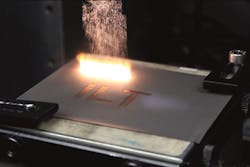Ultrashort-pulse laser ablation helps produce diverse battery electrodes
Lithium-ion batteries that power consumer electronic devices use a wide variety of battery formats on a single production line. This poses a technical challenge for battery vendors, as this has to be done more productively than ever before.
The key production step is coating the metallic substrate foil with active material. This coating is a few-microns-thick layer of paste applied to copper or aluminum. Designated areas of the metal foil have to remain uncoated to provide an electrical contact for the electrodes. The coating process has to be interrupted and restarted repeatedly to create these tabs.
This technical challenge is driving demand for lithium-ion batteries in increasingly diverse sizes and shapes, so the electrode production line has to be fast and flexible. One solution is to coat the entire surface and then use a laser beam to expose just the areas needed for electrical contacts, explains Dr. Karsten Lange, a research fellow with the Micro- and Nano-Structuring Group at the Fraunhofer Institute for Laser Technology (Fraunhofer ILT; Aachen, Germany). “The idea of exposing these areas with a laser had failed in the past due to a lack of productivity on the part of the ablation process. What’s more, the quality of laser ablation did not meet the high standards for a contact point that could be welded easily,” he says.
Substrate foils are from 6 to 15 µm thick and the production line conveyor belts generally run at speeds of around 60 m/min, so the laser process has to expose contact points in a highly productive way without leaving any residue or damaging the delicate substrate foils. Fraunhofer ILT uses an ultrashort-pulse (USP) laser to remove graphite-based anode material from 10-µm-thick copper foil at a rate of up to 1760 mm3/min without damaging it. In the near future, using a new generation of USP laser systems with multikilowatt output power will push the ablation rates even further.
This laser process has proven its merits in the lab and Fraunhofer ILT is looking to ramp the process up for mass manufacturing by installing a high-power USP laser system that is integrated into a roll-to-roll system. This gives the opportunity to investigate laser ablation in a continuous process; Fraunhofer ILT is looking for partners to further develop USP laser ablation in an industry project.
